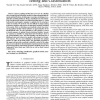Free Online Productivity Tools
i2Speak
i2Symbol
i2OCR
iTex2Img
iWeb2Print
iWeb2Shot
i2Type
iPdf2Split
iPdf2Merge
i2Bopomofo
i2Arabic
i2Style
i2Image
i2PDF
iLatex2Rtf
Sci2ools
127
Voted
TSP
2010
2010
Learning graphical models for hypothesis testing and classification
Sparse graphical models have proven to be a flexible class of multivariate probability models for approximating high-dimensional distributions. In this paper, we propose techniques to exploit this modeling ability for binary classification by discriminatively learning such models from labeled training data, i.e., using both positive and negative samples to optimize for the structures of the two models. We motivate why it is difficult to adapt existing generative methods, and propose an alternative method consisting of two parts. First, we develop a novel method to learn tree-structured graphical models which optimizes an approximation of the log-likelihood ratio. We also formulate a joint objective to learn a nested sequence of optimal forests-structured models. Second, we construct a classifier by using ideas from boosting to learn a set of discriminative trees. The final classifier can interpreted as a likelihood ratio test between two models with a larger set of pairwise features. W...
Artificial Intelligence | Generative Methods | Graphical Models | Sparse Graphical Models | TSP 2010 |
Related Content
| Added | 22 May 2011 |
| Updated | 22 May 2011 |
| Type | Journal |
| Year | 2010 |
| Where | TSP |
| Authors | Vincent Y. F. Tan, Sujay Sanghavi, John W. Fisher III, Alan S. Willsky |
Comments (0)

